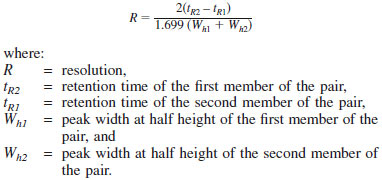ASTM D6729 Standard Test Method for Determination of Individual Components in Spark Ignition Engine Fuels by 100 Metre Capillary High Resolution Gas Chromatography
8. Instrument Check Out Prior to Analysis
8.1 Setting:
8.1.1 Linear Gas Velocity - If the gas chromatograph is equipped with an electronic flow readout device, set the flow to 1.8 mL/min. This is achieved by setting the carrier gas flow rate by injection of methane or natural gas at 35°C. Ensure that the retention time is 7.00 more or less 0.05 min. This corresponds to a linear velocity of 25 to 26 cm/s. This is equivalent to retention times of methane at 0°C ranging from 6.5 to 6.8 min.
8.1.2 If the gas chromatograph is not equipped with an electronic flow readout device, calculate the linear gas velocity in cm/s using Eq 1.

8.1.3 The typical retention times for methane and linear gas velocity for helium are 6.5 to 6.8 and 24 to 26 cm/s, respectively.
8.2 Setting the Split Ratio - If the gas chromatograph is equipped with an electronic split-ratio readout device, set the split ratio to a sample split of 200:1. If the gas chromatograph is not equipped with an electronic split-ratio readout device, one must first calculate column flow rate and then proceed to calculating split ratio using Eq 2 and 3.



8.2.1 The column flow rate is calculated by the use of Eq 2. Use the results obtained from Eq 3 to adjust the split flow until a split flow of approximately 200:1 is achieved.
8.3 Evaluation of Column Performance:
8.3.1 Prior to using the column described in Table 1, measure the resolution of the column under the conditions of Table 2. Check that the resolution for the following pairs of components is obtained using Eq 4 to calculate the resolution of a pair of components:

8.3.1.1 Column resolution should be checked frequently by examining the resolution of these compounds.
8.3.2 Evaluation of the Baseline - Carry out a blank baseline run utilizing no solvent injection, by setting the GC in accordance with the conditions of Table 1.
8.3.3 Subtract the baseline from a sample chromatogram and verify that the residual signal at the beginning of the chromatogram does not differ from the end of the chromatogram by more than 2 %.
8.4 Evaluation of Splitter Linearity - Using the reference gasoline sample, inject this sample according to the schedule listed in Table 3.
8.4.1 Select from the chromatogram about 10 to 15 components, which have concentrations in the range of .01 to 30 weight %. Tabulate for each split ratio the concentrations of the 10 to 15 components. Verify that for each component selected, its concentration does not vary by more than 3 %.



